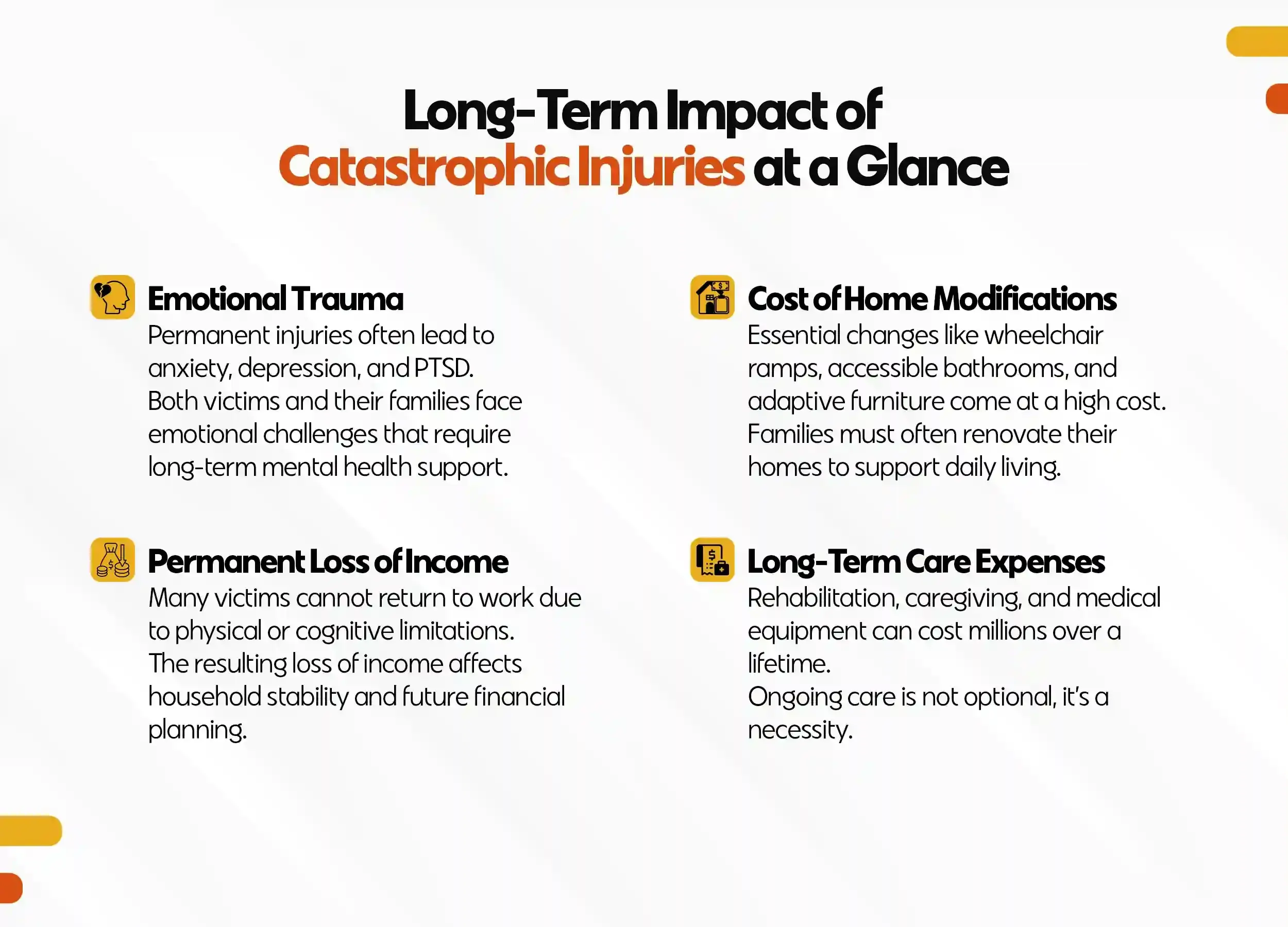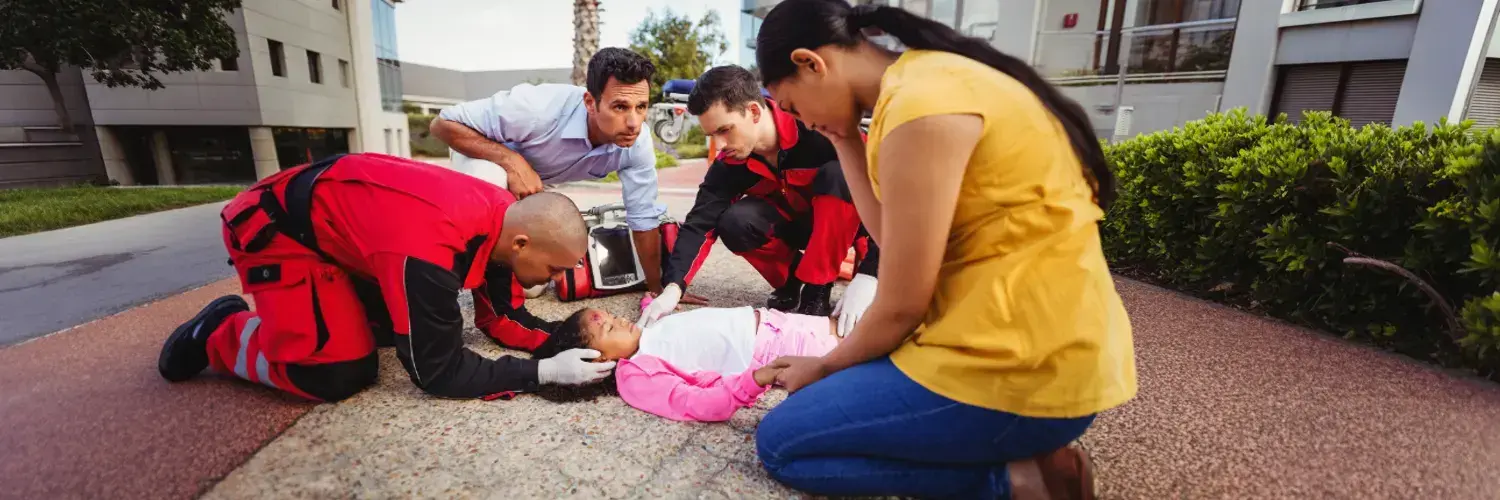The effects of a life-altering injury do not end with the initial trauma. In fact, the long-term impact of catastrophic injuries often unfolds gradually, reshaping the lives of victims and their families in permanent ways. Whether caused by a vehicle collision, workplace accident, or a severe fall, the consequences extend far beyond physical harm and deeply affect emotional and financial well-being.
Understanding the Long-Term Impact of Catastrophic Injuries

To understand the scope of long-term damage, it’s important to define what makes an injury catastrophic in legal and medical terms.
Catastrophic injuries refer to conditions that result in permanent disability and significantly reduce a person’s ability to live independently. These include spinal cord damage, traumatic brain injuries, amputations, or severe burns. The definition goes beyond physical trauma to include the extent of disruption to the victim’s everyday functioning. Many individuals require constant support just to manage basic tasks.
Physical and Emotional Toll
The journey of recovery from a catastrophic injury is both physically demanding and emotionally exhausting. These impacts unfold over time and affect every part of life.
Lifelong Medical Complications
Those affected typically undergo repeated surgeries, long-term rehabilitation, and may need assistive medical equipment. Individuals with spinal cord injuries, for example, face chronic infections and impaired organ function as part of their new reality. Ongoing medical care for injury victims becomes a necessity rather than a choice. Adapting to limited mobility and continuous treatment schedules is part of everyday life. According to the National Spinal Cord Injury Statistical Center, someone with high tetraplegia incurs healthcare costs exceeding $1 million in the first year.
The Emotional Weight
The emotional toll of severe injuries can be as serious as the physical limitations. Anxiety, depression, and post-traumatic stress are common responses to losing independence and experiencing extreme lifestyle changes. Families feel this emotional weight as well. Spouses may shift into caregiving roles, children may take on adult responsibilities, and the overall household dynamic changes. Emotional support and access to counseling are critical for all members involved.
Financial Consequences Beyond Medical Bills
The financial aftermath of a catastrophic injury extends far past the initial hospital stay. These costs continue for years and affect every level of a family's financial planning.
Permanent Loss of Income
The financial impact of catastrophic injury is most obvious when the victim can no longer work. A single income loss can destabilize the entire household. In many cases, victims are unable to return to any form of employment due to physical or cognitive limitations. Even when return-to-work programs exist, they are not suitable for individuals with high care needs or irreversible impairments.
Cost of Care and Home Adjustments
The burden increases when families must invest in structural changes to their homes. These include installing wheelchair ramps, widening doorways, or making bathrooms accessible. Specialized furniture and ongoing professional care services can cost thousands of dollars annually. A study in The Journal of Neurotrauma estimated that the lifetime care cost for traumatic brain injury can exceed $3 million based on severity and age of the patient.
Permanent Disability and Lifestyle Adjustments
Adapting to a new way of life becomes essential after such injuries. Simple actions like bathing or commuting often require external assistance. Everyday life becomes structured around:
- Wheelchairs or powered mobility devices
- Home-use medical equipment
- Scheduled help from caregivers
Families must often change their routines or even relocate to make living conditions suitable for the injured member. The emotional and financial stress of these transitions is long-lasting.
Life After a Traumatic Injury
Although challenging, many victims find ways to adapt and rebuild meaning in their lives. This next phase is as much about mental strength as it is about medical treatment.
Reclaiming Purpose and Identity
Rehabilitation is not only focused on physical health but also on psychological healing and re-establishing a sense of identity. For many, life after traumatic injury involves joining support groups, participating in adaptive sports, or becoming advocates within the community. Reclaiming agency in daily life can greatly improve a survivor’s long-term outlook and confidence.
Legal Support and Advocacy
Accessing professional legal support is crucial for victims and families navigating such complex recoveries. Compensation can ease some of the burden and provide the resources needed to regain control of one’s life. The attorneys at Khan & Cage Law work closely with victims and families to pursue full and fair compensation. They handle a variety of claims involving:
- Ongoing and future medical care
- Lost earning potential
- Pain, suffering, and emotional distress
- Home care and mobility needs
With tailored legal strategies, their team ensures that each client receives the justice and resources they deserve. Working with a catastrophic injury attorney in Dallas is not just a legal decision, but a vital step in long-term recovery planning.
Community and Family Support Systems
Recovery cannot happen in isolation. Beyond legal and medical help, a strong support network is vital to maintaining stability and emotional health. Peer support groups, caregiver education, and access to local nonprofits can help both victims and their families navigate this new phase of life. These support systems provide more than just comfort as they are a source of empowerment. Many organizations offer free resources that guide families through the complexities of caregiving, equipment access, and emotional well-being. Their work ensures that families are not left to figure things out on their own.
Conclusion
The long-term impact of catastrophic injuries reshapes lives physically, emotionally, and financially. Victims often face lifelong challenges that go well beyond the original incident. However, with proper legal representation, community support, and ongoing care, it is possible to rebuild a fulfilling and supported life. If you or someone close to you is facing the reality of a catastrophic injury, now is the time to act. Khan & Cage Law is here to guide you through the legal process while you focus on recovery. Reach out today to secure the support and justice you deserve.
Frequently Asked Questions (FAQs)
1. What qualifies as a catastrophic injury under Texas law?
Catastrophic injuries include brain injuries, spinal cord injuries, amputations, and burns that result in permanent disability or loss of bodily function.
2. Can I claim future medical expenses in my lawsuit?
Yes. A personal injury claim can include anticipated medical expenses, long-term therapy, and rehabilitation costs.
3. What is the time limit for filing a personal injury claim in Texas?
The statute of limitations is generally two years from the date of the injury. Consult an attorney early to avoid missing this window.
4. What happens if the victim is partially at fault for the injury?
Texas follows a modified comparative fault rule. If you are less than 51% at fault, you can still recover damages, though the amount may be reduced.
5. Why should I hire a lawyer even if I have an insurance offer?
Insurance companies often offer low settlements. A qualified attorney can negotiate a fair amount that truly covers your losses and future needs.



